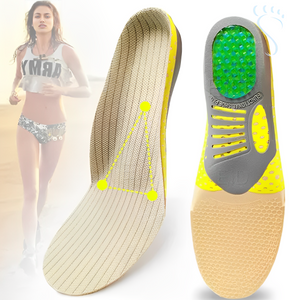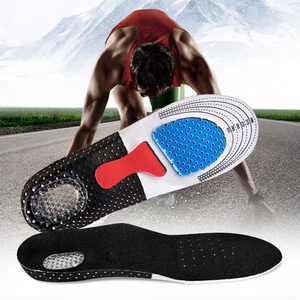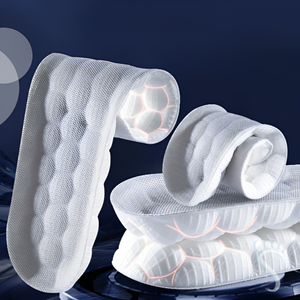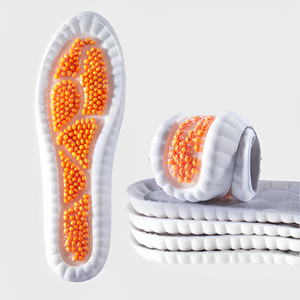Foot Pain: Causes, Symptoms and Treatments
Experiencing foot pain is something many people face at some point in life. It can occur for various reasons and range from mild to severe. Conditions like plantar fasciitis, heel spurs, tendinitis, excessive physical activity, and more can be the cause. Here are some important things you need to know:
A study conducted by the company Pés Sem Dor in 2017 observed that 88.5% of men and 92.5% of women in Brazil experience some level of foot pain. Among those, 14.5% of men and 21% of women report intense pain.
Foot pain is very common among the elderly and women, as these groups are more prone to conditions like osteoarthritis and rheumatoid arthritis, which are highly associated with foot deformities and pain.
What Causes Foot Pain?
Foot pain can have many different causes. Some types begin mildly and worsen over time, such as those from excessive pressure, infections, or systemic health problems. Others happen suddenly due to injury.
Here are some of the most common causes of foot pain:
Plantar Fasciitis
Plantar fasciitis is a common condition that causes pain due to inflammation of the plantar fascia, a band of tissue connecting the heel to the toes. This tissue supports the foot arch and absorbs impact while walking. Overuse or excessive tension may lead to micro-tears, resulting in inflammation and pain in the heel or sole.
This inflammation causes sharp, stabbing pain, especially during the first steps in the morning or after periods of rest. Pain can range from mild to debilitating, significantly affecting quality of life. Proper treatment — including rest, physical therapy, orthotic insoles, and stretching — is essential for recovery.
Heel Spurs
Heel spurs are bony growths that form under the heel due to calcium buildup over time. They are usually caused by repetitive stress from running, standing for long hours, or biomechanical issues in the foot. Some people experience no pain with a heel spur.
Pain arises when soft tissues around the spur are irritated. Pressure from walking or standing can worsen this irritation, causing sharp and persistent heel pain, especially in the morning. Treatment includes supportive footwear, orthotic insoles, physical therapy, and, in some cases, medical intervention.
Metatarsalgia
Metatarsalgia causes inflammation and pain in the ball of the foot, particularly in the metatarsal bones. It is often linked to running, jumping, poor footwear, or foot deformities such as bunions or high arches. Pain may feel like burning or stabbing, especially when standing or walking.
Treatment involves cushioned footwear with arch support and orthotic insoles to redistribute pressure. Rest, ice, and physical therapy can also help reduce inflammation and improve foot mechanics.
Morton’s Neuroma
Morton’s neuroma is a painful condition affecting the nerves between the toes, most commonly between the third and fourth toes. It involves thickening of the tissue around a nerve, causing burning pain, tingling, or numbness in the toes.
It’s often aggravated by tight or high-heeled shoes and repetitive pressure from activities like running. Treatment includes wearing wider shoes, using orthotic insoles to reduce pressure, and avoiding aggravating activities. Early diagnosis helps avoid complications.
Bunions (Hallux Valgus)
Bunions are bone deformities at the base of the big toe, where it angles toward the other toes. This forms a visible and often painful bump. Pain intensifies with walking or wearing tight shoes, and friction may lead to inflammation and calluses.
Treatment focuses on relieving pain and correcting the deformity. Severe cases may require surgery to realign the bones and reduce discomfort.
Stress Fractures
Stress fractures occur due to repetitive movements that overload the bones, common among athletes. Over time, the bones (especially in the feet or shins) weaken and crack. These are often not visible on X-rays and may present only as persistent pain.
Traumatic Fractures
These occur after sudden impact or accidents and involve intense pain. They may also affect muscles and skin. Conditions like osteoporosis increase fracture risk.
Calluses
Calluses form in response to repeated friction or pressure, often on the soles or sides of the toes. While protective, thickened skin can become painful if not managed properly.
Treatment includes wearing proper footwear and, in more severe cases, professional callus removal.
Why Is Foot Pain a Problem?
Several conditions and habits increase foot pain risk:
-
Flat or High Arches: Affect weight distribution and impact absorption.
-
Overpronation or Supination: Misaligned gait causes uneven pressure.
-
Excessive Load: Being overweight or starting intense activity without preparation strains the feet.
-
Injuries: Sports impacts, falls, or dropped objects can all lead to injury.
-
Poor Footwear: Tight, narrow, or high-heeled shoes contribute to pain and deformities.
Understanding these factors helps prevent foot issues and maintain foot health.
Diagnosing Foot Pain
Diagnosis is key to identifying the cause of foot pain and choosing the right treatment. A qualified professional will review medical history, assess symptoms, and perform a physical exam. Gait analysis and mobility assessments are also common.
Proper diagnosis may reveal plantar fasciitis, heel spurs, Morton’s neuroma, or other issues. Treatment recommendations may include therapy, orthotic insoles, medication, or footwear adjustments.
Foot Pain Treatment
Each condition requires specific treatment, but some general strategies help:
-
Reduce Foot Impact: Weight loss and reduced exercise intensity.
-
Muscle Strengthening: Reduces tissue friction and injury risk.
-
Physical Therapy: Includes targeted exercises, TENS, ultrasound, or laser therapy.
-
Orthotic Insoles: Realign joints and reduce overload on the feet.
-
Proper Footwear: Avoid tight shoes or high heels. Choose supportive, comfortable options.
-
Medication: Analgesics and anti-inflammatories may be prescribed under medical supervision.
Pisato Orthotic Insoles for Foot Pain
Pisato’s insoles offer personalized support and lasting comfort. They correct foot biomechanics, redistribute pressure, and relieve stress on critical areas. This helps treat plantar fasciitis, heel spurs, metatarsalgia, and Morton’s neuroma.
By supporting the foot arch and absorbing shock, Pisato insoles reduce inflammation and pain, promoting better balance and walking comfort.
They’re a non-invasive solution that significantly improves quality of life. Designed to match your unique anatomy, Pisato insoles prevent condition worsening and new injuries.
Footwear for Foot Pain
Choosing the right shoes is essential. Ideal shoes provide arch support, cushioning, and toe space. Breathable materials and shock-absorbing soles help too. Avoid narrow, high-heeled shoes.
Custom footwear is also a great option, ensuring proper fit and even weight distribution. Brands like Pés Sem Dor offer custom shoes to relieve pain and enhance daily comfort.
Frequently Asked Questions
What are the types of foot pain?
Common types include plantar fasciitis, Morton’s neuroma, heel spurs, bunions, fractures, and tendinitis.
What can I do to relieve foot pain?
-
Rest and avoid aggravating activities
-
Apply ice to reduce inflammation
-
Elevate the foot to reduce swelling
-
Stretch and strengthen foot muscles
-
Wear supportive shoes
-
Gently massage the affected area
What causes foot pain when stepping?
It may be due to plantar fasciitis, heel spurs, fractures, or tendon injuries. The pain often worsens when putting weight on the affected foot.
What are the most common causes of foot pain while walking?
Plantar fasciitis, heel spurs, Morton’s neuroma, tendinitis, and poor footwear are typical causes. Intense physical activity and excess weight can worsen symptoms.
How can I relieve foot pain while walking?
Use cushioned shoes and custom orthotic insoles. Stretch and strengthen the feet and ankles. Consult a healthcare provider if pain persists.
Why do I feel intense foot pain when waking up and taking the first steps?
This is commonly caused by plantar fasciitis. Overnight, the fascia tightens, and pain is triggered when it stretches during the first morning steps.
What are the best ways to treat morning foot pain?
Stretch the plantar fascia before getting out of bed. Night splints may help. Orthotic insoles can also support long-term relief.






